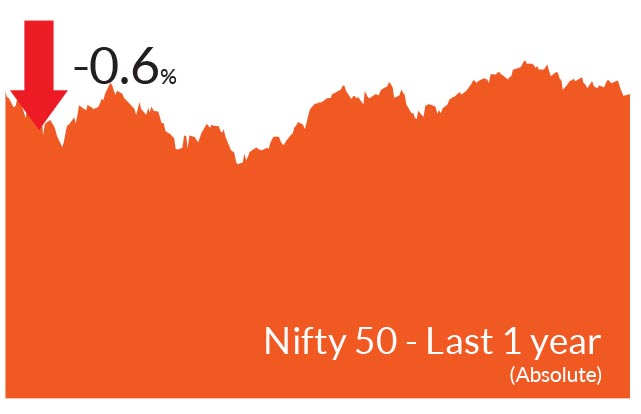► Equity market valuations are broadly reasonable adjusted for the cyclical low in earnings and
potential for revival going forward.
► We remain bullish on equities from a medium to long term perspective.
► Investors are suggested to have their asset allocation plan based on one's risk appetite and future goals in life.
► We remain bullish on equities from a medium to long term perspective.
► Investors are suggested to have their asset allocation plan based on one's risk appetite and future goals in life.


► Yield curve flat - Duration plays can be played in the 2-4 year segment.
► Elevated levels can be used to lock in longer term rates.
► Spreads between G-Sec/AAA & SDL/AAA have seen some widening.
► Credits continue to remain attractive from a risk reward perspective give the improving macro fundamentals.
► Elevated levels can be used to lock in longer term rates.
► Spreads between G-Sec/AAA & SDL/AAA have seen some widening.
► Credits continue to remain attractive from a risk reward perspective give the improving macro fundamentals.
Indian markets continued to see weakness amidst heightened volatility
driven by global factors. S&P BSE Sensex & NIFTY 50 ended the month
marginally positive. NIFTY Midcap 100 & NIFTY Small cap 100 ending
the month down 0.3% & 1.8% respectively. FPI's were buyers for the
first time this calendar year investing ~$1 billion in the equity markets
for the month of March 2023.
The volatility during the month was caused by a regional banking collapse in the US and fears of financial contagion, brought on by Credit Suisse, one of the world's premier banking institutions. The bank ultimately secured a regulatory backed take over by a rival banking group amidst a 'crisis of confidence'. Regulators promptly acted, in both cases, to quell any fears of a financial crises through policy action and emergency market support measures. Markets saw this as a big positive, recovering swiftly and returning to stability.
► MF Taxation Change - Life after Mar 31st doesn't change much: The Finance ministry made some surprise amendments to the Finance Bill 2023 before passing it through both houses of parliament. Amongst them were removal of LTCG benefits to select categories of mutual fund schemes. For investors, while the new taxation structure may seem detrimental in the near term, the market linked nature of the products and single point taxation at the time of redemption make debt mutual funds relatively attractive as compared to comparable fixed savings instruments.
► Positive Comments from the US Fed - US Rates drop: The US Fed raised rates by 25bps as expected. The commentary coupled with tightness in system liquidity due to the banking crisis were seen as indications of a pause/peaking interest rates. US bond yields dropped significantly through the month with maximum gains coming in the 2-4-year segment (75-80bps drop). Positive inflation data trends, make the case of incrementally stable rates stronger.
The volatility during the month was caused by a regional banking collapse in the US and fears of financial contagion, brought on by Credit Suisse, one of the world's premier banking institutions. The bank ultimately secured a regulatory backed take over by a rival banking group amidst a 'crisis of confidence'. Regulators promptly acted, in both cases, to quell any fears of a financial crises through policy action and emergency market support measures. Markets saw this as a big positive, recovering swiftly and returning to stability.
Key Market Events
► Inflation & Rates - RBI commentary keenly awaited: India remains a key beneficiary from falling oil prices. The ripple effects of lower commodity prices are likely to help sooth inflation in the latter half of the year. Domestic CPI for the month of February stood at an elevated 6.4%. Initial signs of an inflation cool off have been witnessed in the US with inflation core PCE falling below 5%. Prices of Timber and the metal complex have already retraced to pre-covid levels signaling a stabilization of prices in the aftermath of global supply chain issues. RBI comments post policy on April 6th are likely to be triggers for market movements for the month.► MF Taxation Change - Life after Mar 31st doesn't change much: The Finance ministry made some surprise amendments to the Finance Bill 2023 before passing it through both houses of parliament. Amongst them were removal of LTCG benefits to select categories of mutual fund schemes. For investors, while the new taxation structure may seem detrimental in the near term, the market linked nature of the products and single point taxation at the time of redemption make debt mutual funds relatively attractive as compared to comparable fixed savings instruments.
► Positive Comments from the US Fed - US Rates drop: The US Fed raised rates by 25bps as expected. The commentary coupled with tightness in system liquidity due to the banking crisis were seen as indications of a pause/peaking interest rates. US bond yields dropped significantly through the month with maximum gains coming in the 2-4-year segment (75-80bps drop). Positive inflation data trends, make the case of incrementally stable rates stronger.
Market View
Equity MarketsWe have witnessed 'momentum' & 'beta' plays making way for 'fundamentals' and 'quality'. The limelight on corporate governance has also brought back focus on companies with a proven management track record and profit pedigree. Many of these names today trade at attractive valuations in contrast to the rest of the market. The winners of 2023 is likely to look starkly different from 2022. This coupled with buoyancy on the economic front bode well for investors looking to build a highly quality centric portfolio.
Currently, our portfolios favour large caps where companies continue to deliver on growth metrics. Corporate earnings of our portfolio companies continue to give us confidence in the strength of our portfolio companies. From a risk perspective, in the current context, given rising uncertainties our attempt remains to minimize betas in our portfolios. The markets have kept 'quality' away from the limelight for over 18 months, making valuations of these companies relatively cheap both from a historical context and a relative market context.
While we remain cautious of external headwinds, strong discretionary demand evident from high frequency indicators and stable government policies give us confidence that our portfolios are likely to weather the ongoing challenges.
Debt Markets
The current curve remains very flat with everything in corporate bonds beyond 1 year up to 15 years is available @7.5-7.80% range. We expect the curve to remain flat for most part of 2023 with long bonds trading in a range for most part of 2023 (7.25-7.75%). Falling CPI, weaker growth and strong investor demand would keep yields under check despite high G-Sec supply next year.
We retain our stance of adding duration to portfolios in a staggered manner given that a large uncertainty driving rates and duration calls in now out of the way. For investors with a medium term investment horizon, we believe the time has come to incrementally add duration to bond portfolios.
For investors with medium term investment horizon (3 Years+), incremental allocations to duration may offer significant risk reward opportunities. Spreads between G-Sec/AAA & SDL/AAA have seen some widening over the last month which could make a case for allocations into high quality corporate credit strategies. Lower rated credits with up to 18-month maturity profiles can also be considered as ideal 'carry' solutions in the current environment.
Source: Bloomberg, Axis MF Research.


